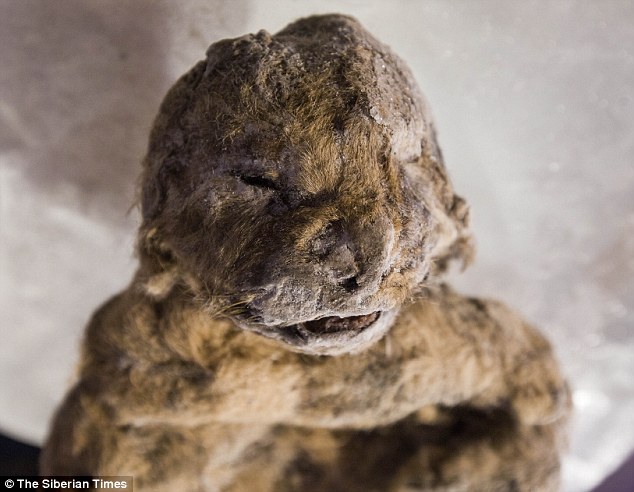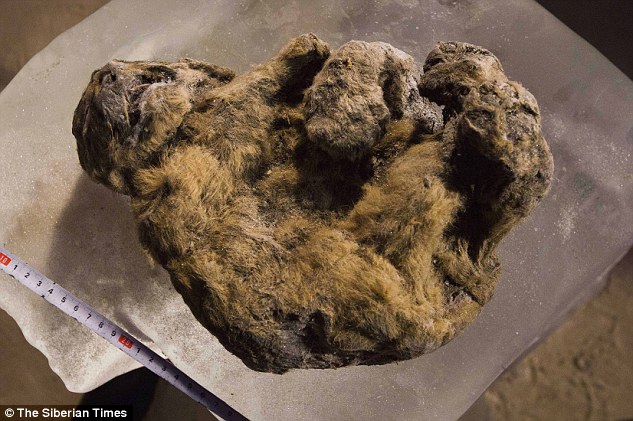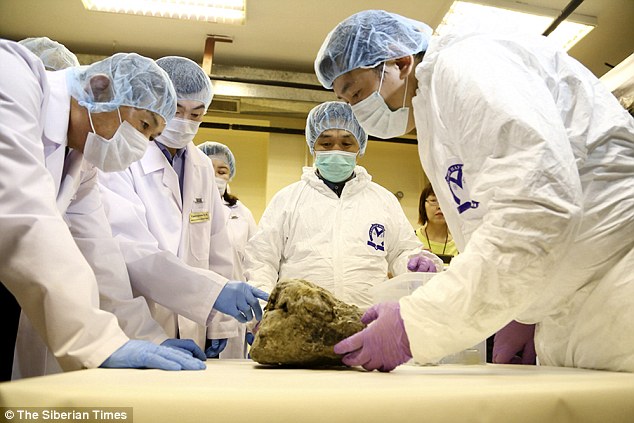

Scientists are trying to clone extinct cave lions after the 12-000-year old, perfectly preserved remains of two cubs was discovered in Siberia.
The South Korean team seeking to reanimate the pair, found around 650 miles from the local capital of Yakutsk, is already trying to bring back the long extinct woolly mammoth.
Experts have said the 'perfectly preserved' predators, named Uyan and Dina, are a 'sensational find'.

The South Korean team seeking to reanimate the cave lions (pictured) named Uya and Dina is already trying to bring back the woolly mammoth. The demise of the species is a puzzle since the animal had few predators, was smaller than herbivores, and not prone to getting bogged down in swamps unlike woolly mammoths.

The perfectly preserved predators (pictured) were found around 650 miles from the Siberian capital of Yakutsk.
Controversial cloning expert Hwang Woo-Suk visited Yakutsk this week to watch over scientists as they removed samples of skin and muscle tissue from a young cave lion.
He was embroiled in a bizarre dispute with Siberian scientists over the size of the samples he could take to experiment on.
Hwang was 'unhappy with the samples', said Semyon Grigoriev, director of the world famous Mammoth Museum in Yakutsk.
He told the Siberian Times: 'They expected to take more, as they did with the woolly mammoth previously.

Experts have said the 'perfectly preserved' predators, named Uyan and Dina, are a 'sensational find'. An adult European cave lion is thought to have measured 3.9ft (1.2metres) tall and 6.9ft (2.1metres) in length without its tail, based on a skeleton found in Germany.

Research on the two cubs (pictured) could help to explain why the species died out around 10,000 years ago, say experts. Cave lion fossils have also been found in Alaska and Canada. Remains are rare, making the recent find particularly exceptional, and only fragments of carcasses and skeletons have been found before.
'But it will not work with with these little kittens. You have to understand, the lion cub is very small, so it was not possible to get as much as we would like.'
One of the cubs is being kept in a Russian freezer indefinitely to await scientific advances in cloning.
'The methods of research are constantly being improved - about once a decade there is a mini-revolution,' said Dr Albert Protopopov, head of the mammoth fauna studies department of the Yakutian Academy of Sciences.
He added: 'So we will do everything possible to keep this carcass frozen for as long as possible.'
'We managed to take some samples of skin along with the muscle tissue, and we hope that we will find what we want in these samples.'
Cave lions lived during Middle and Late Pleistocene times on the Eurasian continent, from Britain to the extreme east of Russia. They also roamed Alaska and north western Canada.
Research on the two cubs could help to explain why the species died out around 10,000 years ago, say experts.
The demise of the species is a puzzle since the animal had few predators, was smaller than herbivores, and not prone to getting bogged down in swamps unlike woolly mammoths and rhinos.

Controversial cloning expert Hwang Woo-Suk visited Yakutsk this week to watch over scientists as they removed samples of skin and muscle tissue from a young cave lion.

Remains are rare, making the recent find particularly exceptional, and only fragments of carcasses and skeletons have been found before. The discovery will give scientists a better idea of what the animals that once roamed Yakutia looked like.
The predators lived during Middle and Late Pleistocene times on the Eurasian continent, which stretched from the UK to Chukotka in East Russia, connected by the Bering land bridge.
Cave lion fossils have also been found in Alaska and Canada.
Remains are rare, making the recent find particularly exceptional, and only fragments of carcasses and skeletons have been found before.
The discovery will give scientists a better idea of what the animals that once roamed Yakutia looked like.

The discovery was made in the Sakha Republic, otherwise known as Yakutia (shaded in red) and scientists believe the two 'sensational' cubs are the best preserved ever found.
Until now, their impressions were based on a handful of skulls, teeth and bones found in the freezing region.
Careful study of the remains may help explain why prehistoric cave lions became extinct.
One theory holds that a decline in deer and cave bears, their prey, caused their demise.
In 2006, Hwang was dismissed by Seoul National University for faking groundbreaking work in stem cell research.
The university said Hwang had damaged its and his country's reputation. But he has gone on to be seen as a pioneer of cloning efforts.
Day|Week

 Qiandaohu supply ship named 'model ship' by PLA Navy
Qiandaohu supply ship named 'model ship' by PLA Navy Stunning Kuche on the Silk Road
Stunning Kuche on the Silk Road Tunisian man creates art of sand in Hangzhou
Tunisian man creates art of sand in Hangzhou Goddess teacher shares fitness program online
Goddess teacher shares fitness program online Getting close to PLA's easternmost post on the mainland
Getting close to PLA's easternmost post on the mainland 'Naked run' race held in Beijing
'Naked run' race held in Beijing Train Attendant Recruitment Held in East China
Train Attendant Recruitment Held in East China In pics: Russia's Su-35 fighter jets
In pics: Russia's Su-35 fighter jets Young monks learn kungfu in NE China temple
Young monks learn kungfu in NE China temple Scenery of Guzhu, thousand-year-old ancient village in E China
Scenery of Guzhu, thousand-year-old ancient village in E China